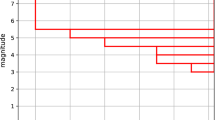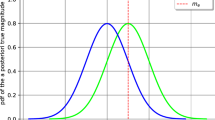Abstract
Seismic risk analyses derive from earthquake catalogs a recurrence relation linking earthquake activity rate to magnitude. The most widely employed model is the log-linear Gutenberg–Richter relation (Gutenberg and Richter, Science, 83, 183–185, 1936; Gutenberg and Richter, Bulletin of the Seismological Society of America, 46(3), 105–145, 1945), with modifications at larger magnitudes (Cosentino et al., Bulletin of the Seismological Society of America, 67, 1615–1623, 1977; Kijko and Sellevoll, Bulletin of the Seismological Society of America, 79(3), 644–654, 1989; Page, Bulletin of the Seismological Society of America, 58, 1131–1168, 1968; Pisarenko and Sornette, Pure and Applied Geophysics, 160, 2343–2364, 2003; Turcotte, Physics of the Earth and Planetary Interiors, 111, 275–293, 1999). This relation leads to exponentially distributed magnitudes truncated to a maximum magnitude, a priori fixed under geophysical considerations. In this paper, we assume seismic events occur according to a Poisson distribution, but we propose to model the tail distribution of magnitudes with a generalized Pareto distribution (GPD). The GPD parameters are estimated with a maximum likelihood procedure. This GPD-based model gives rise to a new recurrence model that differs from the Gutenberg–Richter Law. It eliminates the need to introduce a maximum magnitude in the analysis that is difficult to determine. This paper details the expression of the estimators of the GPD parameters and the asymptotic normal distribution when the shape parameter \(\xi >-1\). This asymptotic distribution yields confidence intervals for all parameters. The GPD parameter estimators account for the following features of the data set: (a) seismic events are collected on periods whose span depends on their magnitudes; (b) magnitudes are imprecisely known: each magnitude is supposed to uniformly belong to an interval of length 0.5. Our new model is estimated from information coming from the FCAT17 catalog. This catalog collects seismic events from the Alps region in France. We conduct an uncertainty analysis, and we quantify the impact of estimation uncertainty on the recurrence model.
















Similar content being viewed by others
References
Baudin, M., Dutfoy, A., Popelin A.L., & Iooss, B. (2017). OpenTURNS: An Industrial Software for Uncertainty Quantification in Simulation, Springer, www.openturns.org.
Cara, M., Cansi, Y., Schlupp, A., & Arroucau, P. (2015). SiHEX: a new catalog of instrumental seismicity for metropolitan France. Bull Soc Geol Fr, 186, 3–19. https://doi.org/10.2113/qssqfbull.186.1.3, www.franceseisme.fr.
Cara, M., Denieul, M., Sèbe, O., Delouis., B., Cansial Y., & Schlupp A. . (2017). Magnitude \(M_w\) in metropolitan France. Journal of Seismology, 21, 551–565. https://doi.org/10.1007/s10950-016-9617-1.
Cosentino, P., Ficara, V., & Luzio, D. (1977). Truncated exponential frequency-magnitude relationship in earthquakes statistics. Bulletin of the Seismological Society of America, 67, 1615–1623.
Drees, H., Ferreira, A., & de Haan, L. (2004). On maximum likelihood estimation of the extreme value index. Annals of Applied Probability, 14, 1179–1201.
Dutfoy, A. (2018). Estimation of tail distribution of the annual maximum earthquake magnitude using extreme value theory. Pure and Applied Geophysics, 170(9–10), 1361–1372.
Dutfoy, A.(2020). Estimation of the Gutenberg-Richter earthquake recurrence parameters for unequal observation periods and imprecise magnitudes, Pure and Applied Geophysics 177(10) 4597-4606.
Dutfoy, A., & Senfaute G. (2021). “A New Generation of Earthquake Recurrence Models Based on The Extreme Value Theory and Impact on Probabilistic Seismic Hazard Assessments”, Bulletin of Earthquake Engineering, in review.
Manchuel, K., Traversa, P., Baumont, D., Cara M., Nayman E., & Durouchoux C. (2017). The French seismic CATalogue (FCAT-17), Bulletin of Earthquake Engineering 16(10) 2227-2251, https://doi.org/10.1007/s10518-017-0236-1.
Keller, M., Pasanisi, A., Marcilhac, M., Yalamas, Th., Secanell, R., & Senfaute, G. (2014). A Bayesian methodology applied to the estimation of earthquake recurrence parameters for seismic hazard assessment. Quality and Reliability Engineering International, 30(7), 921–933.
Kijko, A., & Sellevoll, M.A. (1989). Estimation of earthquakes hazard parameters from incomplete data files. Part I. Utilization of extreme and incomplete catalogs with different threshold magnitudes, Bulletin of the Seismological Society of America 79(3) 644–654.
Kijko, A., & Sellevoll, M.A. (1992). Estimation of earthquakes hazard parameters from incomplete data files. Part II. Incorporation of magnitude heterogeneity, Bulletin of the Seismological Society of America 82(1) 120-134.
Page, R. (1968). Aftershock and microaftershocks. Bulletin of the Seismological Society of America, 58, 1131–1168.
Pisarenko, V. F., Sornette, A., Sornette, D., & Rodkin, M. V. (2014). Characterization of the tail of the distribution of earthquake magnitudes by combining the GEV and GPD description of extreme value theory. Pure and Applied Geophysics, 171, 1599–1624.
Pisarenko, V. F., & Sornette, D. (2003). Characterization of the frequency of extreme earthquakes events by the generalized Pareto distribution. Pure and Applied Geophysics, 160, 2343–2364.
Pisarenko, V. F., & Sornette, D. (2004). Statistical detection and characterization of a deviation from the Gutenberg–Richter distribution above magnitude 8’’. Pure and Applied Geophysics, 161, 839–864.
Pisarenko, V. F., Sornette, A., Sornette, D., et al. (2008). New approach to the characterization of Mmax and of the tail of the distribution of earthquake magnitudes. Pure and Applied Geophysics, 165, 1–42.
Gutenberg, B., & Richter, C. F. (1936). Magnitude and energy of earthquakes. Science, 83, 183–185.
Gutenberg, B., & Richter, C. F. (1945). Earthquakes magnitude, intensity, energy and acceleration. Bulletin of the Seismological Society of America, 46(3), 105–145.
Riera J.D., & Iturrioz, I. (2015). Influence of seismic source geometry in PSHA predictions in stable continental regions, Transactions, SMiRT-23 Manchester, UK.
Senfaute, G., Pecker, A., Labbé, P., et al. (2015). Contribution of the SIGMA research program to analyses of uncertainties in seismic hazard assessment, 9ième Colloque National. France: AFPS.
Database SISFRANCE (2021) www.sisfrance.fr.
Traversa, P., Manchuel, K., & Mayor, J. (2014). ”On the use of cross-border macroseismic data to improve the estimation of past earthquakes seismological parameters, 2ECEES conference 12, Istanbul, Turkey.
Smith, R. (1987). Estimating tails of probability distributions. Annals of Statistics, 15, 1174–1207.
Turcotte, D. L. (1999). Seismicity and self-organized criticality. Physics of the Earth and Planetary Interiors, 111, 275–293.
Weichert, D. H. (1980). Estimation of the earthquake recurrence parameters for unequal observation periods for different magnitudes. Bulletin of the Seismological Society of America, 70(4), 1337–1346.
Zhou, C. (2009). Existence and consistency of the maximum likelihood estimator for the extreme value index. Journal of Multivariate Analysis, 100, 794–815.
Zhou, C. (2010). The extent of the maximum likelihhod estimator for the extreme value index. Journal of Multivariate Analysis, 101, 971–983.
Author information
Authors and Affiliations
Corresponding author
Additional information
Publisher's Note
Springer Nature remains neutral with regard to jurisdictional claims in published maps and institutional affiliations.
Rights and permissions
About this article
Cite this article
Dutfoy, A. Earthquake Recurrence Model Based on the Generalized Pareto Distribution for Unequal Observation Periods and Imprecise Magnitudes. Pure Appl. Geophys. 178, 1549–1561 (2021). https://doi.org/10.1007/s00024-021-02712-3
Received:
Revised:
Accepted:
Published:
Issue Date:
DOI: https://doi.org/10.1007/s00024-021-02712-3




